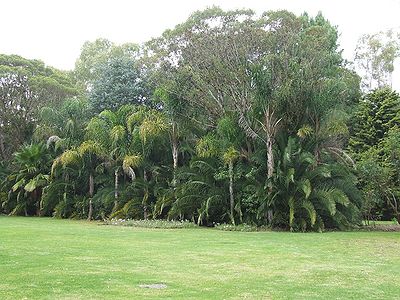Tree

A tree is a large florum with a single hard main stem which may branch at some distance from the ground into other stems or branches but is clearly dominant to them. If the central stem does not branch, it must at least have some sort of structure at the top; a single bare pole would not be considered a tree. The tree form offers a number of advantages, and trees have independently evolved in many unrelated taxa. Even on True Earth, all Euterran trees belong to the plant kingdom but pertain to a number of different divisions within it, the form having separately arisen multiple times.
A young tree is known is a sapling. This term arose with reference to Euterran plants that have within them a liquid substance known as sap, but has come to refer to the young of other trees that lack this substance as well.
The study of trees is known as dendrology.
Anatomy
Trees vary widely within the defined parameters, and of course unrelated trees may have very different forms and compositions. Still, there are some frequent commonalities, and some terminology has developed to describe them. The central stem of a tree is generally called the trunk, and the subsidiary stems branches. (Not all trees have branches; the Euterran palm trees, for instance, have only a single stem, with leaves at the top.) If the branches subdivide into yet more stems, the smallest sub-branches are called twigs. If, as is often the case, a tree sends down support structures underground, these are known as roots (as is the case with many other flora). Almost all Euterran trees bear leaves upon their twigs and branches, but even on True Earth this rule has an exception in the saguaro.
The hard substance making up the majority of the tree's substance is called wood, although naturally the composition of the wood varies by tree. The outer covering of the tree, where it is clearly distinct from the wood, is known as the bark.
Varieties
True Earth contains about a hundred thousand species of tree, most of which belong to the division Magnoliophyta, of flowering plants. This predominance is a relatively recent phenomenon, however, on the geological timescale; a hundred million years ago, angiosperm trees were outnumbered by conifers, trees of the division Pinophyta, which are still common but now less so than flowering trees. In even earlier years, many other types of plants grew into trees, including horsetails and lycophytes. Even today, a few other types of trees survive, albeit in smaller numbers than the dominant flowering trees and conifers, including tree ferns, ginkgos, and cycads.
Trees exist on other worlds pertaining not only to other kingdoms, but to other empires and fœdera entirely. Fungus trees are not uncommon on some worlds, as well as underwater trees of algae. On other planets where life arose independently, trees exist totally unrelated to Euterran trees, but still with a similar basic form through parallel evolution.
A plant which has a similar structure to a tree but has multiple trunks, or branches near the ground, is called a shrub. The line between a shrub and a tree, however, is not always a clear one, and there may be some species of flora that grow into trees under some circumstances and into small shrubs in others.
Groups of trees
Trees often grow in clusters, commonly enough that special names exist for such groupings of trees. A small bunch of trees is called a copse; a slightly larger group may be a grove. An artificial grouping of fruit trees maintained for regular harvest is called an orchard. A large area covered by trees is known as a forest, and may be further classified according to the climatic conditions or the types of trees present: a wet tropical forest is often called a jungle (though many biologists reserve that word for the densest, most impenetrable parts of the forest), while a cold forest made up predominantly of conifers is a taiga.
Depending on the types of trees, the trees within a forest or smaller grouping may or may not communicate with each other in some way. Even in Euterra, there is some limited transmission of information between trees in the form of chemical signals; under some circumstances, some trees undergoing certain types of stress (such as parasites or unusual temperatures) may release chemicals that prompt nearby trees to build up defenses against the threats. Other kinds of trees on other worlds may have more detailed and sophisticated means of communication, which may lead to coöordination of certain activities throughout a forest or to other complex collective behavior.
Uses
A tree is virtually a whole ecosystem in and of itself, providing a variety of environments for other organisms to thrive. Various life forms can live on or within the trunk, or among the branches, or on or in the leaves. Some trees may even have special structures they grow specifically to house commensal organisms; others may be induced by parasitic organisms to develop structures they would not otherwise bear.
Many trees may provide other resources too. The very material that the trunk is made of may be useful for construction; certainly Euterran trees are harvested for their wood. But many other parts of the tree may be profitable as well; like other flora, trees may provide fruit, or nuts, or edible tubers. Some trees may have leaves that lend themselves to various uses; others may have useful internal fluids (this is the original source of rubber, chicle (the base of chewing gum), amber, and maple syrup, among other substances); the bark of still others might have useful properties (hence, for example, cork and cinnamon).
See also
Tree on Wikipedia